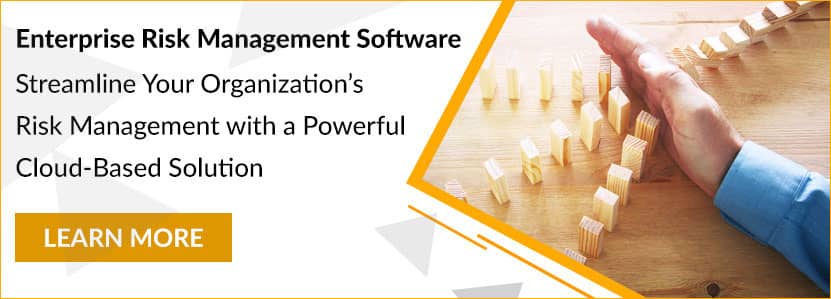Home/ Blog / The Limits of Spreadsheets Versus Risk Management Platforms
Spreadsheets are a common way to store and analyze data in businesses operating in every industry globally. As good as spreadsheets are, certain limitations show up when it comes to specialized domains. Risk managers have used spreadsheets to collect risk data, track the progression of different tasks, create risk models, and much more. However, modern risk management platforms provide a much more robust toolset to risk managers and have made spreadsheet-based risk management an obsolete practice for efficiency.

The Limits of Spreadsheets
While spreadsheets may have many advantages, the problem is that their limitations outweigh their capabilities when it comes to risk management. Spreadsheets are fine for small businesses that want to store data in an organized manner. Any business that wants more intelligence out of their data will not be able to do so using spreadsheets.
Data Processing Limits
There are many limits to the type of data processing that can be done through spreadsheets. There are limits to the amount of data that can be meaningfully stored in a spreadsheet while still keeping the spreadsheet readable. There are also limits to how much data can be imported from other sources for analytics. This severely hampers the analytical capabilities that are necessary for efficient risk management practices. Each time a spreadsheet is modified, the ties between the data are destroyed, making it impossible to assess relationships across time. Without these connections, it becomes more challenging to connect hazards and their controls. Additionally, they provide limited access to historical and current data, making historical comparisons difficult.
Time and Labor Intensive
Risk management necessitates collecting a vast volume of data, which frequently leads to a huge number of spreadsheets that are linked together. This can be very difficult to do in a manual risk management framework that uses spreadsheets. A minor modification to the data structure becomes a massive task. As a result, risk managers are forced to spend numerous hours confirming data, double-checking formulae, and revising numbers, a time-consuming procedure. Thus, significant labor combined with a working knowledge of shortcuts and formulas is required.
How Risk Platforms Enhance Risk Management
Modern risk management platforms provide features that help businesses overcome the productivity limits inherent in spreadsheet-based risk management.
Risk management platforms provide a robust toolset to risk managers and have made spreadsheet-based risk management an obsolete practice for efficiency Share on XAutomated Data Collection
Modern risk management platforms collect data from risk-related documents and tasks automatically. Data from external sources can be easily imported into the risk management framework and used for analytics. This results in an exponential increase in an organization’s data storage and data analysis capabilities. All the data is standardized automatically, ensuring that no labor hours need to be wasted painstakingly preparing all the data for analytics.
Advanced-Data Analytics
The data collected by modern risk management systems are used for advanced data analytics that provides insights and predictions about risks. Current data is compared with historical data to extrapolate trends and detect emerging risks. External data is imported and used as key risk indicators to understand the current risk level of the organization. Such insights help the risk management team quickly mitigate risks and proactively put in controls throughout the risk framework.
Understanding the Prevalence of Spreadsheets
The limits of spreadsheets are severe, so why are they so commonly used throughout the industry? There are several factors:
Historical Precedent
Spreadsheets have been the best available tool for the job over the past few decades. While better options are available now, the fact that so many people in the risk management sphere are used to working with spreadsheets ensures their popularity.
However, doing things one way simply because that is the way they have always been done is never an efficient way of doing things. Modern risk management platforms provide a better way to manage risks.
Easy to Use
Almost every professional in the banking industry (and most other industries) is already familiar with spreadsheets. This makes them accessible and ensures that businesses do not have to train their employees to use them.
A decade or two ago, this was a problem for businesses when risk management platforms were new and difficult to use. Modern risk management platforms are remarkably easy to use and do not require any extensive training.
Customizable
Spreadsheets can be customized to do many different types of analytics and visualizations. People have used spreadsheets for in-depth analytics and much more. This ensures that people in many industries can customize spreadsheets to use them in any way that is needed.
There is no need for such customization in modern risk management platforms because they are designed to be used by specialists. Risk management platforms are designed around risk management workflows and can be used directly once deployed.
Cost Minimization
Most businesses already pay for productivity software such as the Microsoft Office suite of applications. This means that they do not need to spend any money to give their employees spreadsheet software. It is practically ‘’free’’ for businesses to manage risks using spreadsheets.
Risk management platforms are now common in the financial sector because the ROI on them is remarkable. The problem is that there are many losses that the organization must bear because of the inefficiency of spreadsheet-based risk management frameworks. Spreadsheets require many labor hours to use and maintain, which increases labor costs. The lack of analytics means businesses can often not detect risks in time, which can cause financial losses and even result in monetary penalties levied by regulatory authorities. Businesses realize that the cost saved by modern risk technology is much more than the cost of risk technology.
Request a Demo
Complete the form below and our business team will be in touch to schedule a product demo.
By clicking ‘SUBMIT’ you agree to our Privacy Policy.




